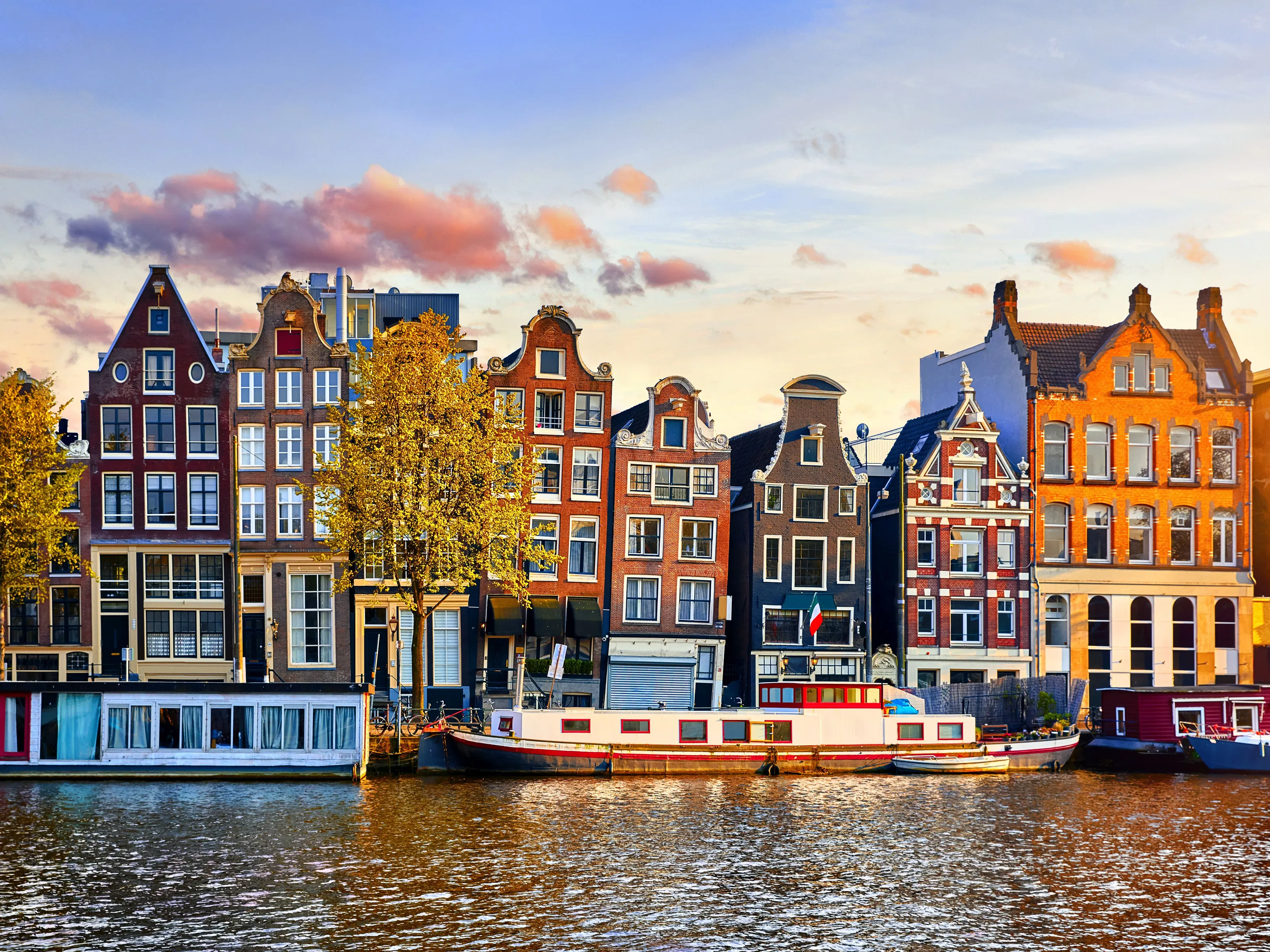Why Visit Copenhagen?
Copenhagen embodies Scandinavian cool where sleek design meets cozy hygge, bicycles outnumber cars, and New Nordic cuisine revolutionized global gastronomy. Denmark's compact capital charms with Nyhavn's rainbow-colored 17th-century townhouses lining the waterfront where Hans Christian Andersen once lived, their reflections shimmering in the canal beside wooden sailing ships and outdoor cafés. Tivoli Gardens, the world's second-oldest amusement park (1843), enchants with rides, gardens, and evening fairy lights that inspired Walt Disney.
The Little Mermaid statue perches modestly on a harbor rock, while Amalienborg Palace's royal guards march in bearskin hats past modernist architecture and waterfront saunas where Danes brave frigid winter swims. Copenhagen's food scene dominates global lists—Noma pioneered foraging and fermentation, while Reffen street food market, Torvehallerne's gourmet stalls, and smørrebrød (open-faced sandwiches) at traditional lunch spots celebrate Danish ingredients. The city's sustainable vision shines in car-free zones, harbor baths for swimming, and bicycles as main transport (around 400 km of bike lanes).
Freetown Christiania's alternative community occupies former military barracks with murals, music venues, and green spaces. Museums span the National Gallery's art to the Design Museum's chairs, while Ny Carlsberg Glyptotek's sculpture garden offers discounted or free entry on specific days. Day trips reach Kronborg Castle (Hamlet's Elsinore) and Swedish Malmö across the Øresund Bridge.
With mild summers, magical winter hygge, bikes everywhere, and quality of life consistently ranked world's best, Copenhagen delivers Danish happiness and design excellence.
What to Do
Copenhagen Classics
Tivoli Gardens
Historic amusement park from 1843 right in the city centre. Admission uses dynamic pricing but typically starts from around DKK 200 for entry only, with ride passes from roughly DKK 280–300 and bundle tickets even higher—always check Tivoli's site for your exact date. You pay extra per ride unless you get a wristband, so it can add up quickly if you don't like rides. Evening is the most magical time, when the lanterns and lights come on and there are concerts and fireworks in season.
Nyhavn Waterfront
The classic postcard harbour with colourful 17th-century houses and old wooden boats. It's free to wander but sitting down for a drink on the quay is pricey (beer often DKK 80–120). For photos, stand on the 'sunny side' (north side) in the afternoon. Canal tours leave from Nyhavn and usually cost about DKK 100–150 for an hour-long ride that loops past the Little Mermaid, the Opera House and Amalienborg Palace.
The Little Mermaid Statue
Copenhagen's most famous statue and also its most divisive sight—she's only about 1.25m tall and often surrounded by tour groups. It's free to visit and you can walk there in about 15–20 minutes from Nyhavn via the waterfront and Kastellet fortress. Go early in the morning if you want unobstructed photos; otherwise, treat it as a quick stop on a longer harbour walk rather than a stand-alone mission.
Rosenborg Castle
A small Renaissance castle in the King's Garden that houses Denmark's crown jewels and royal regalia. Adult tickets cost around DKK 140 and anyone under 18 goes free; there's also a joint ticket with Amalienborg Palace for about DKK 215 that's valid for 48 hours. The surrounding park is free and perfect for a picnic. Inside, allow 60–90 minutes to see the royal apartments, Great Hall and basement treasury.
Danish Culture
Rent a City Bike
Cycling is how locals actually get around. Use the Bycyklen e-bike system (roughly DKK 30 per hour pay-as-you-go) or rent a classic bike from a shop for about DKK 75–150 per day. Stick to the dedicated bike lanes, signal clearly, and never ride on the pavement. Easy routes include along the harbour, out to the beach at Amager Strand, or across the bridges to Christiania and the islands.
Christiania Free Town
Christiania is a semi-autonomous community in former army barracks—murals, workshops and cafés make it a fascinating, if controversial, part of the city. Entry is free but remember you're in a residential neighbourhood, not an amusement park. You'll see open cannabis trade in and around Pusher Street even though it's illegal in Denmark; we don't recommend buying or using it and police do carry out raids. Respect the local rules, especially the strict ban on photography on Pusher Street, and keep your camera away from any dealers.
Strøget Shopping & Latin Quarter
Strøget runs about 1.1 km from City Hall Square towards Nyhavn and is one of Europe's longest pedestrian shopping streets—mostly big-name brands and chains. The real charm lies in the side streets of the nearby Latin Quarter, where you'll find vintage shops, design stores and cosy cafés. Avoid restaurants with touts and tourist menus here too; walk a block or two away from the main drag for more local places to eat.
Food & Hygge
Smørrebrød & Danish Lunch
Smørrebrød—open-faced sandwiches on rye bread—are the classic Danish lunch. Expect to pay roughly DKK 80–150 per piece depending on toppings and location, and order 2–3 for a full meal. Try herring, roast pork with crackling (flæskesteg) or egg and shrimp. Aamanns does a modern take; more traditional options are scattered around the city and often close by 2–3pm, since smørrebrød is a lunch thing, not dinner.
Torvehallerne Food Market
Two glass halls by Nørreport Station packed with around 60–80 stalls—coffee, pastries, tapas, fish, and fresh produce. It's open daily, generally from about 10:00–19:00 (shorter hours and a later start on Sundays). It's not cheap, but it's a fantastic place to graze: grab a coffee from Coffee Collective, smørrebrød, or a pastry and use the outdoor benches. Weekends get packed; weekday late mornings are calmer.
Hygge Experience
Hygge is that Danish mix of cosiness and contentment rather than a specific sight. Feel it in candlelit cafés on dark winter afternoons, picnic blankets in King's Garden on summer evenings, or a slow bike ride along the harbour. Warm up with a kanelsnegl (cinnamon roll), browse a beautifully designed public library, or join locals at a free harbour bath for a quick swim—little, everyday rituals rather than big-ticket attractions.
Gallery
Travel Information
Getting There
- Airports: CPH
Best Time to Visit
May, June, July, August, September
Climate: Moderate
Weather by Month
| Month | High | Low | Rainy days | Condition |
|---|---|---|---|---|
| January | 7°C | 3°C | 12 | Good |
| February | 7°C | 3°C | 18 | Wet |
| March | 7°C | 2°C | 9 | Good |
| April | 11°C | 5°C | 6 | Good |
| May | 14°C | 7°C | 10 | Excellent (best) |
| June | 20°C | 14°C | 10 | Excellent (best) |
| July | 18°C | 13°C | 14 | Excellent (best) |
| August | 22°C | 16°C | 7 | Excellent (best) |
| September | 18°C | 12°C | 8 | Excellent (best) |
| October | 13°C | 10°C | 16 | Wet |
| November | 10°C | 7°C | 9 | Good |
| December | 6°C | 4°C | 16 | Wet |
Weather data: Open-Meteo Archive (2020-2024) • Open-Meteo.com (CC BY 4.0) • Historical avg. 2020–2024
Budget
Excludes flights
Visa Requirements
Schengen Area
💡 🌍 Traveler Tip (November 2025): Best time to visit: May, June, July, August, September.
Practical Information
Getting There
Copenhagen Airport (CPH) is 8km from center, connected by Metro M2 (about DKK 36 / ~$5 12-15 min to the centre). Trains also run frequently (DKK 36). Taxis cost DKK 250-300/$37–$43 Øresund trains connect Malmö, Sweden (35 min). Copenhagen is Scandinavia's rail hub—direct trains to Hamburg (4h30min), Stockholm (5h30min).
Getting Around
Metro (M1-M4, driverless, 24/7), S-trains, buses, and harbor buses cover the city. Tickets: about 24-30 DKK for a 2-zone single. City Pass Small 24h from ~100 DKK; all-zones 24h card around 130 DKK. Copenhagen is famously bikeable—cycle lanes are protected and extensive. Rent city bikes (Donkey Republic app) or traditional bikes. Walking is pleasant in compact center. Taxis expensive.
Money & Payments
Danish Krone (DKK, kr). Exchange $1 ≈ DKK $71 ≈ DKK 6.90. Copenhagen is nearly cashless—cards and mobile pay accepted everywhere, including hot dog stands and public transport. Many places don't accept cash at all. No need for ATMs. Tipping: service included, round up for exceptional service.
Language
Danish is official, but Copenhagen has among the world's highest English proficiency—virtually everyone speaks fluent English, often with perfect American accent from media consumption. Communication is effortless. Learning 'Tak' (thanks) and 'Hej' (hi) is appreciated but unnecessary.
Cultural Tips
Bike culture is serious—stay in bike lanes, signal turns, don't block them as pedestrians. Cyclists have right of way. Coffee culture: order kaffe (filter), cafe latte, or specialty roasts. Lunch 12-2pm, dinner 6-9pm (early by European standards). Hygge (cozy contentment) is real—embrace candlelit evenings. Smørrebrød eaten with knife and fork. Book restaurants weeks ahead. Many shops close Sundays. Swimming culture means public nudity at some beaches is normal.
Perfect 3-Day Copenhagen Itinerary
Day 1: Royal Copenhagen
Day 2: Museums & Harbor
Day 3: Alt Culture & Design
Where to Stay in Copenhagen
Indre By (City Center)
Best for: Main sights, Nyhavn, Strøget shopping, hotels, central location
Vesterbro
Best for: Meatpacking District nightlife, hipster cafés, Carlsberg brewery, diverse
Nørrebro
Best for: Multicultural dining, street food, vintage shops, local vibe, cheaper
Christianshavn
Best for: Canals, Christiania, quieter atmosphere, modern architecture
Frequently Asked Questions
Do I need a visa to visit Copenhagen?
What is the best time to visit Copenhagen?
How much does a trip to Copenhagen cost per day?
Is Copenhagen safe for tourists?
What are the must-see attractions in Copenhagen?
Popular Activities
Top-rated tours and experiences in Copenhagen
Ready to Visit Copenhagen?
Book your flights, accommodation, and activities






